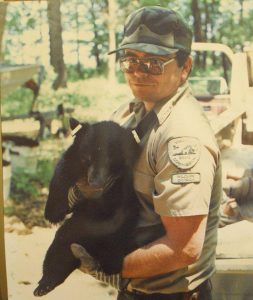After a treaty meeting with the Cherokee at Ft. Chiswell in 1750, Dr. Thomas Walker, with three Cherokee guides, made his way across southwest Virginia into eastern Kentucky. His diaries of that trip, now in the Library of Virginia in Richmond, give great detail of that journey through the wilderness. Of particular interest to me was the wildlife he encountered along his way. While traveling down the spine of what today is named Walker Mountain he repeatedly spoke of his many encounters with the area’s black bear, stating that on one day alone they met 13.
The black bear in Virginia has had a checkered history. Honored as a brother by the Indian, he became a nuisance to the pioneer, raiding the easy pickings of the homestead hog lot, garden and chicken coop. The bear was treated as a nuisance by state law, which set the hunting season for them legislatively, instead of being regulated by the state Game Department, as were other game animals. That legislative season was long and effective; by the 1970’s the black bear had disappeared from much of its traditional southwest Virginia range.
That changed in 1978 with the control of bear season finally being placed into the hands of the Game Department, who had restoration plans ready to go. A ten-year moratorium was placed on bear hunting in the counties south of Interstate 81 and west of state route 91, so restocking could take place.
 I joined the Virginia Game Department as a wildlife management area supervisor in 1978. I had been a trapper since age 17, but in my new job I was tasked with (among many other duties) nuisance animal trapping in those 11 counties of southwestern Virginia. With the new bear project I was assigned, along with Larry Crane from Giles County, to assist Jerry Blank, our Game Department State Trapper. Jerry took me to trapping school. You see, we were to trap nuisance bears from other areas of the state and transport them as seed stock for re-establishing the bear population. For a wildlife guy, it was a dream come true.
I joined the Virginia Game Department as a wildlife management area supervisor in 1978. I had been a trapper since age 17, but in my new job I was tasked with (among many other duties) nuisance animal trapping in those 11 counties of southwestern Virginia. With the new bear project I was assigned, along with Larry Crane from Giles County, to assist Jerry Blank, our Game Department State Trapper. Jerry took me to trapping school. You see, we were to trap nuisance bears from other areas of the state and transport them as seed stock for re-establishing the bear population. For a wildlife guy, it was a dream come true.
In the eight years I participated in the project I was in on handling nearly 300 bears. In areas where my game warden-grandfather had hunted nuisance bears in the 1940’s and 1950’s, I restocked bears in to the unoccupied habitat. Today the bear population in those southwest counties is thriving and supporting a shortened and very successful hunting season. The black bear is back in Virginia and we are all better off for it.
Our Appalachian heritage is ripe with stories of bro’ bruin, from those of Daniel Boone and Davy Crockett to many wonderful contemporary writers of today. The bear is at his essence the symbol of Appalachia; a story of wealth, loss and rebirth that shows our love of this land.
Just knowing he’s out there makes me smile.
**Photo: In 1980 a young Walt Hampton holds a tranquilized cub just before the cub, his sister and mother were transported to Grayson County for release.

